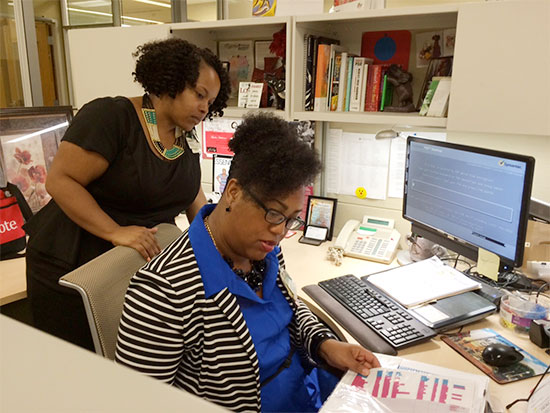 Ramona Colvin (standing) and Myeisha Hutchinson, patient navigators with UAB's Patient Care Connect program, work together to help patients through their cancer journey.Every diagnosis of cancer comes with fear, anxiety, even confusion. Patients are faced with crucial decisions and have an urgent need for information they can trust. Most of all, patients need someone to help guide them through the complex challenges and barriers that cancer treatment presents.
Ramona Colvin (standing) and Myeisha Hutchinson, patient navigators with UAB's Patient Care Connect program, work together to help patients through their cancer journey.Every diagnosis of cancer comes with fear, anxiety, even confusion. Patients are faced with crucial decisions and have an urgent need for information they can trust. Most of all, patients need someone to help guide them through the complex challenges and barriers that cancer treatment presents.
The University of Alabama at Birmingham and Guideway Care have announced a partnership to expand the reach of UAB’s proven cancer navigation program, Patient Care Connect, to patients nationally.
The UAB Patient Care Connect program was funded by a $15 million Center for Medicare and Medicaid Innovation grant to help create a national model for improving outcomes while reducing unnecessary health care utilization, as well as decreasing the cost of cancer care.
The national implementation of the program will be led by Guideway Care, which provides knowledgeable cancer care guides, processes and technology to assist cancer patients, especially during the periods in between clinical visits.
“Building on the proven methodology created at UAB, Guideway Care provides patient guidance beyond navigation,” said Craig Parker, CEO of Guideway Care. “Guideway Care arms Care Guides with proven processes, advanced communication protocols and purpose-built patient communication technology to help patients navigate obstacles during a difficult and stressful diagnosis.”
The UAB Patient Care Connect program succeeded locally by using nonclinical resources to resolve barriers patients encounter during their cancer journey. Specific results during UAB’s program implementation include:
- 55 percent reduction in hospitalizations: Hospitalization rates dropped significantly from 35.8 percent to 16.1 percent in the navigated patient population.
- 29 percent reduction in ER visits: ER visits decreased from 30.7 percent to 21.8 percent in the navigated patient population.
- 60 percent reduction in ICU admissions: With ICU admissions, a dramatic reduction occurred from 10 percent to 4 percent in the navigated patient population.
- 45 percent reduction in overall cost: In terms of Medicare claims, there was a considerable reduction of overall cost in the navigated patient population from $15,091 to $8,269 per patient per quarter, which is a Medicare savings of $6,822 per navigated patient. Cost in the last six months of life decreased from $23,735 to $16,764, a 29 percent reduction per patient for the navigated patient population, in comparison to the non-navigated group that increased from $13,418 to $15,544.
In “Resource Use and Medicare Costs During Lay Navigation for Geriatric Patients With Cancer,” published by JAMA Oncology in January, the UAB team reported that an “estimated potential 10:1 return on investment” of the UAB cancer navigation program “helps make a financial case to organizational leadership for sustainability of navigation programs.”
By pursuing patient engagement outside the traditional model, which focuses on clinic-based care, the “navigators are uniquely positioned to meet the needs of these high-risk patients and help them better use outpatient resources.”
Not only did the program have a remarkable impact on the cost of care as reported in the JAMA Oncology article, the Centers for Medicare and Medicaid Services’ (CMS) independent third-party assessors, the National Institutes for Health-funded NORC at the University of Chicago, found a significant improvement in satisfaction among patients.
The introduction of CMS’ Oncology Care Model, or OCM, is recognition of the importance of programs such as Guideway Care. The OCM aims to provide higher-quality, more highly coordinated oncology care at the same or lower cost. The more than 200 participants in the OCM are required to provide the core functions of patient navigation.
The Guideway Care program meets and exceeds the core functions by surrounding patients with the resources and guidance so desperately needed during their cancer journey. In a recent article published in the March 2017 issue of Health Affairs titled “Innovative Oncology Care Models Improve End-of-Life Quality, Reduce Utilization and Spending,” researchers from both NORC and CMS stated, “Under this model, participating practices are required to redesign themselves to include several aspects of [the Patient Care Connect] program.”
“Bundled payments are coming — transferring risk and financial burden to providers,” said Edward Partridge, M.D., director of the UAB Comprehensive Cancer Center. “It is absolutely necessary to transition from fee-for-service thinking, and prepare our physicians and hospital delivery systems for performance-based payment models.
“The Guideway Care program positions cancer centers to be on the forefront of this movement while differentiating themselves with an outstanding patient experience.”
